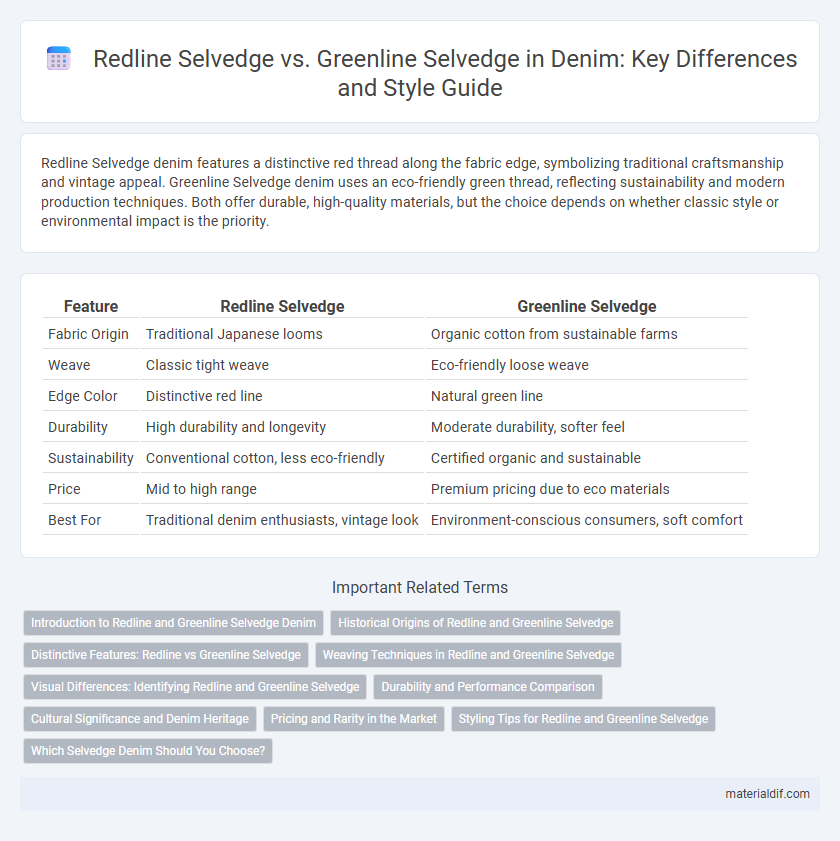Redline Selvedge denim features a distinctive red thread along the fabric edge, symbolizing traditional craftsmanship and vintage appeal. Greenline Selvedge denim uses an eco-friendly green thread, reflecting sustainability and modern production techniques. Both offer durable, high-quality materials, but the choice depends on whether classic style or environmental impact is the priority.
Table of Comparison
| Feature | Redline Selvedge | Greenline Selvedge |
|---|---|---|
| Fabric Origin | Traditional Japanese looms | Organic cotton from sustainable farms |
| Weave | Classic tight weave | Eco-friendly loose weave |
| Edge Color | Distinctive red line | Natural green line |
| Durability | High durability and longevity | Moderate durability, softer feel |
| Sustainability | Conventional cotton, less eco-friendly | Certified organic and sustainable |
| Price | Mid to high range | Premium pricing due to eco materials |
| Best For | Traditional denim enthusiasts, vintage look | Environment-conscious consumers, soft comfort |
Introduction to Redline and Greenline Selvedge Denim
Redline selvedge denim features a distinct red stitching along the inner edge of the fabric, symbolizing premium quality and traditional shuttle loom production. Greenline selvedge denim, identified by a green stripe on the selvedge, offers a unique aesthetic variation while maintaining the durability and craftsmanship associated with selvedge denim. Both Redline and Greenline selvedge denims are prized for their tight weave, durability, and authentic vintage appeal favored by denim enthusiasts.
Historical Origins of Redline and Greenline Selvedge
Redline selvedge denim traces its origins to the early 20th century, manufactured by denim mills like Cone Mills in the United States, where the distinct red line on the edge became a mark of premium quality. Greenline selvedge, introduced later as a variation, stemmed from eco-friendly production initiatives aiming to reduce environmental impact, often associated with organic cotton and sustainable dyes. Both types reflect distinct historical contexts: redline symbolizes traditional American workwear heritage, while greenline represents modern sustainable innovation in denim manufacturing.
Distinctive Features: Redline vs Greenline Selvedge
Redline selvedge denim is characterized by its vivid red edge, symbolizing traditional craftsmanship and high-quality Japanese manufacturing, often associated with durability and a vintage aesthetic. Greenline selvedge denim features a subtle green edge, signifying organic or eco-friendly cotton usage and sustainable production methods, appealing to environmentally conscious consumers. Both styles showcase tight, clean weaves and are prized for their unique texture and premium fade patterns, but redline emphasizes heritage while greenline highlights sustainability.
Weaving Techniques in Redline and Greenline Selvedge
Redline Selvedge denim is woven using vintage shuttle looms that produce a tighter and more durable edge with a distinctive red thread, enhancing fabric strength and preventing fraying. Greenline Selvedge, on the other hand, often employs modern automated looms with environmentally friendly dyes and a green thread, emphasizing sustainable production without sacrificing quality. The weaving technique in Redline prioritizes traditional craftsmanship and toughness, while Greenline integrates eco-conscious processes with consistent fabric integrity.
Visual Differences: Identifying Redline and Greenline Selvedge
Redline selvedge denim features a distinctive bright red stripe running along the edge of the fabric, making it easily recognizable and highly sought after for its classic look. In contrast, greenline selvedge denim displays a subtle green stripe that offers a unique, understated appearance favored by those seeking a variation from traditional red. Both types showcase the tightly woven edge characteristic of selvedge denim, but the color of the selvedge line is the key visual identifier distinguishing redline from greenline selvedge.
Durability and Performance Comparison
Redline selvedge denim features a tighter weave and higher thread count, enhancing its durability and resistance to wear compared to greenline selvedge. Greenline selvedge denim offers a softer feel but sacrifices some strength and longevity, making it less suitable for heavy-duty use. Performance-wise, redline selvedge maintains shape and resists fraying better during repeated washes and extensive wear.
Cultural Significance and Denim Heritage
Redline Selvedge denim carries a deep cultural significance rooted in the original American denim mills, symbolizing authenticity and classic craftsmanship treasured by denim enthusiasts worldwide. Greenline Selvedge, often representing a modern revival or eco-conscious approach, reflects a shift toward sustainability while maintaining a connection to traditional selvedge production techniques. Both variants embody the rich heritage of denim, with redline emphasizing vintage prestige and greenline highlighting contemporary values in the evolving denim culture.
Pricing and Rarity in the Market
Redline selvedge denim is typically priced higher due to its historical significance and limited production, making it rarer and more sought-after by collectors. Greenline selvedge, by contrast, is more common and often made with eco-friendly processes, resulting in more accessible pricing and broader availability. Market demand for redline denim drives its premium value, while greenline offers practical appeal with sustainability-conscious consumers.
Styling Tips for Redline and Greenline Selvedge
Redline selvedge denim, characterized by its vibrant red edge and robust weave, pairs exceptionally well with rugged boots and vintage leather jackets for a bold, classic look. Greenline selvedge denim, known for its softer, more organic feel and eco-friendly production, complements casual footwear like white sneakers and lightweight cotton shirts, enhancing a laid-back, sustainable style. For a sharp contrast, cuff redline selvedge jeans to showcase the iconic red edge, while greenline selvedge looks great with a natural roll that highlights its subtle green color for understated sophistication.
Which Selvedge Denim Should You Choose?
Redline selvedge denim is prized for its traditional craftsmanship and higher quality cotton, resulting in a stiffer fabric with a vintage feel, making it ideal for enthusiasts seeking durability and classic appeal. Greenline selvedge denim offers a more flexible and lightweight option, favored for its softer texture and eco-friendly production methods, suitable for those prioritizing comfort and sustainability. Choosing between redline and greenline selvedge depends on whether you value rugged durability and heritage aesthetics or modern softness and environmentally conscious manufacturing.
Redline Selvedge vs Greenline Selvedge Infographic

 materialdif.com
materialdif.com